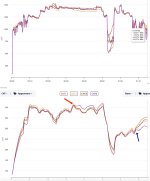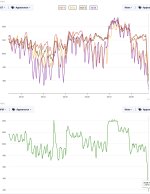Draker
Well Known Member
Hey, engine masters,
Could use a little help diagnosing. Lycoming YIO-360-M1B. 37 hours total time.
I was in the middle of a phase 1 test flight today. I took the -7A up to 16.5K indicated, 18.5K density altitude to check high altitude performance. CHTs got a little hot but not past my "personal redline" of 425F. At some point during the climb, CHT4 suddenly broke away from the pack [see pic 1] and remained 10-15 degrees hotter than the rest of them. I decided not to continue testing and did a descent to cool everything back off.
Once I was back on the ground, CHT4 was noticeable cooler than the rest. Then, during taxi, at idle-ish low throttle settings, RPM was all over the place [see pic 2]. Every 8 seconds or so, it would drop by about 200RPM and EGT 2 and 4 would also drop like a brick. Engine stumbled, then recovered, only to repeat that pattern over and over until I taxied all the way back. The periodic stumbling was less severe taxiing at higher RPM.
Where do you suggest I start looking? I plan to check the basics, look for leaks, look at the plugs, stick a borescope inside #4 and so on, but any helpful insights? This is the first kind of scary squawk I've had so far.
Could use a little help diagnosing. Lycoming YIO-360-M1B. 37 hours total time.
I was in the middle of a phase 1 test flight today. I took the -7A up to 16.5K indicated, 18.5K density altitude to check high altitude performance. CHTs got a little hot but not past my "personal redline" of 425F. At some point during the climb, CHT4 suddenly broke away from the pack [see pic 1] and remained 10-15 degrees hotter than the rest of them. I decided not to continue testing and did a descent to cool everything back off.
Once I was back on the ground, CHT4 was noticeable cooler than the rest. Then, during taxi, at idle-ish low throttle settings, RPM was all over the place [see pic 2]. Every 8 seconds or so, it would drop by about 200RPM and EGT 2 and 4 would also drop like a brick. Engine stumbled, then recovered, only to repeat that pattern over and over until I taxied all the way back. The periodic stumbling was less severe taxiing at higher RPM.
Where do you suggest I start looking? I plan to check the basics, look for leaks, look at the plugs, stick a borescope inside #4 and so on, but any helpful insights? This is the first kind of scary squawk I've had so far.
Attachments
Last edited:










